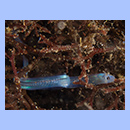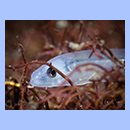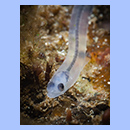- Kingdom: Animalia
- Phylum: Chordata
- Subphylum: Vertebrata
- Superclass: Gnathostomata
- Class: Actinopterygii
- Order: Anguilliformes
- Family: Anguillidae
- Scientific name: Anguilla anguilla
- Norwegian: ål
Characteristics:
The larvae is vertically flattened, translucent white and may reach a length of 7 cm.
When entering the glass eel phase it actually shrinks somewhat and take the proportions more similar to an adult eel. It remains translucent, but starts to grow yellow pigmentation on the head and the tail fin.
The eel gradually grow into an adult eel. The pigmentation increases and the colors changes into the yellow tinted brown, typical for adult eels. In contrast to the larger European conger, the jaw is undershot. As all other true eels it lacks ventral fins. A dorsal fin is running along the last two thirds of the body.
The male may grow to a length of 50 cm while the bigger female may reach 13 kg and a length of 150 cm.
Habitat:
The eel is catadromous, i.e. it leaves freshwater to spawn in sea. The European eel spawn in the North Atlantic Ocean, more specifically in the Sargasso Sea. The larvae follow the Gulf Stream across the Atlantic Ocean, towards Europe. When they reach the European coast they transform into glass eels. As soon as they reach the coast they seek into freshwater. They usually swim up rivers, but are known to be able to cross dry land to enter ponds and lakes. Here they grow into so called yellow eels. After 6-25 years they may have reached a length of 60-80 cm. During the summer, grown eels seek back to the ocean to spawn again. How they are able to return to the Sargasso Sea, against the Gulf Stream, is not fully understood.
Distribution:
The European eel is known along the entire European coast, from Murmansk and Iceland to North-West Africa, the Mediterranean and the Black sea.



